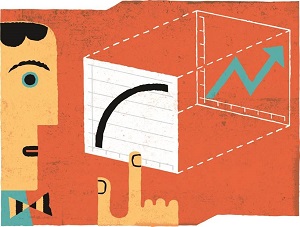A yield curve is a chart that plots the yield on a given bond — that is, the interest rate offered at current market prices — at every available maturity. Usually a yield curve displays the shortest maturities on the left and the longest maturities on the right. It is a snapshot in time: You can replot a yield curve as fast as market expectations change, meaning today's yield curve may not look the same as tomorrow's.
The yield curve is a simple concept, but what it means is much debated. The idea is to understand factors influencing short- versus long-term interest rates, but multiple factors affect both. Those factors include the risk that the bondholder won't be repaid (called the bond's credit risk); expected inflation (since inflation reduces the real value of a bond, though some bonds are indexed to inflation such that their yields don't include a premium for inflation risk); a term premium (compensation for tying up the investor's funds for the given time period, though this can be a benefit if an investor wants to lock in a given return); and the short-term rates that are expected to prevail over the life of the bond. Any time expectations about those factors change, a yield curve is liable to change shape. But it won't necessarily be obvious which components have shifted to cause that change.
An upward-sloping yield curve is the most common. But if short-term interest rates are expected to fall, a yield curve can flatten or even become downward sloping. That's often interpreted to suggest that market participants see a recession on the horizon, and with it, looser monetary policy.
And yield curves have often been correct about recessions. In a 2009 study comparing yield curves to common forecasting methods, San Francisco Fed President John Williams and Executive Vice President and Senior Policy Advisor Glenn Rudebusch found that the slope of the yield curve does far better at predicting recessions three and four quarters out than economists and professional forecasters do using all the information and data available to them. That said, the yield curve has falsely "predicted" recessions, most notably in 1966 and in 1998, the Cleveland Fed has pointed out. And the yield curve is generally flatter today than it used to be as inflation in many countries has become lower and more stable.
Moreover, factors beyond the economic forecast also affect longer-term yields. The Fed raised its policy rate no fewer than 17 times between June 2004 and June 2006, but long-term rates stayed steady and even declined. This was especially unusual given the perceived health of the economy at the time. Then-Fed Chairman Alan Greenspan famously called this bond market behavior a "conundrum," which remains partly a mystery.
For monetary policy, the yield curve can be both a predictive economic indicator and a measure of monetary policy's effects. Though the Fed directly controls only very short-term interest rates, it does have tools for influencing longer-term rates, which are the rates that drive much of economic activity — the rates on consumer loans and major business investments, for example.
The Fed's influence, or lack thereof, over longer-term rates became a focus after the Great Recession. Once the Fed pushed short-term policy rates as low as they could go — the zero lower bound — it sought to continue stimulating the economy by pushing down longer-term interest rates through three avenues. First, it signaled its intent to keep monetary policy loose for a long time to come, suppressing the expected path of short-term rates. Second, it purchased large quantities of long-term securities like treasuries and mortgage-backed securities to push up their market price and push down their yields. Third, the Fed exchanged short-term securities on its balance sheet for longer-term ones to further "twist" the yield curve.
Estimates differ on the extent to which these moves successfully lowered long-term rates. The yield curve did steepen dramatically when Bernanke hinted the end of these extraordinary actions, which had the effect of tightening financial conditions. Some even wondered whether this tightening would, ironically, force the Fed to delay its return to conventional monetary policies. A focus today has been on what will happen as the Fed returns to "normal" monetary policy in which short-term interest rates are the key policy lever. (See "Time to Unwind.") Many observers don't expect the same volatility this time since the Fed's next policy moves seem more clear to markets. (See "Unwinding the Fed's Asset Purchases," Econ Focus, Second Quarter 2017.)
Still, as normalization continues, the Fed will likely be watching the yield curve as one important measure of how its policy changes are being interpreted by financial markets.




